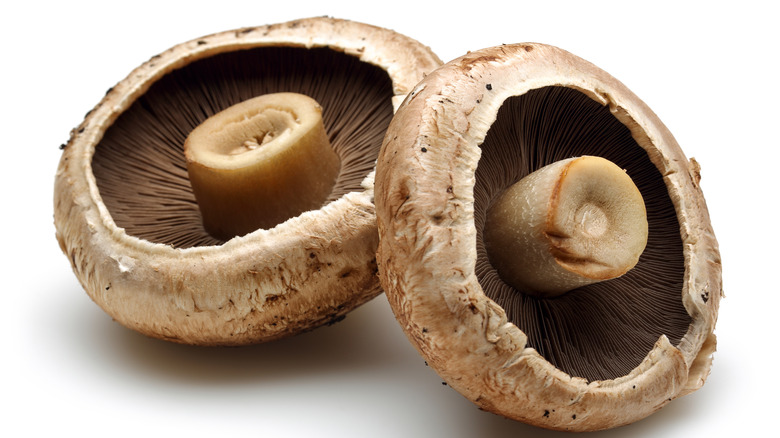How Portobello Mushrooms Became So Trendy In Recipes
Going to a get-together and finding out that the entrée has a portobello mushroom on it is definitely a fancy surprise — and a delicious one! The portobello mushroom is often preferred over other mushroom varieties for its richness, meatiness, and pronounced flavor.
According to Fine Cooking, this mushroom was discovered by accident when farmers let the cremini mushrooms, small and rounded mushrooms with no visible gills, grow a little longer and mature enough to develop gills. They thusly grew darker and became the portobello that we know today. Cooks value this shroom's versatility: It can be roasted, grilled, fried, or pan-seared. Plus, this mushroom is a valuable meat substitute, a go-to for vegetarians that crave a portobello mushroom burger once in a while.
However, this aged type of mushroom wasn't always trendy in recipes and wasn't even that expensive. In fact, there was a solid moment when it wasn't easy to sell these mushrooms. It took time for portobellos to get their place in the spotlight, but just what caused their explosion in popularity? Apparently, a group of chefs, sustainable eaters, and avid marketers were part of the team responsible for this.
Portobello mushrooms became popular in the 1980s for their dietary value
According to Lovefood (via MSN), portobello mushrooms went overlooked by the masses until a surge of popularity struck them in the 1980s. Folks deemed them "ugly," but it was later discovered that their growth process was fair and that it was a mushroom with a more intense flavor than other types mushrooms on the market. Naturally, this drew people with bolder palettes to try the mushroom, and that's when they fell in love. Then, chefs and enthusiastic home cooks decided to give it a go for their recipes.
With more sales, the portobello started to appear in media: It was 1998, for example, when a piece in The New York Times discussed the "mushroom mania" happening across the U.S. The piece reported that 80% of chefs surveyed by the National Restaurant Association included mushrooms as part of the list of chic foods. In 1995, The Baltimore Sun talked about an Ohio-based chef that seasoned the mushroom with Cajun seasoning and served it on top of pasta with Pomodoro sauce. The same piece shared that recipe because the portobello was on its way to rock home kitchens.
At the same time, people started noticing what a great source of nutrients and proteins is. In the 1990s, the portobello mushroom skyrocketed in the market due to the number of people shifting to a whole foods lifestyle, a diet consisting of choosing whole and locally-sourced foods (via LoveToKnow). That's when this healthy and peculiar mushroom became a sensation in sustainable kitchens, and it stayed that way.
Because of all of these events, the portobello mushroom is what it is today: the chic and trendy mushroom we all want to cook with and take a bite from.

